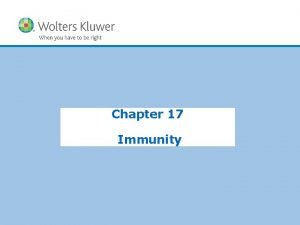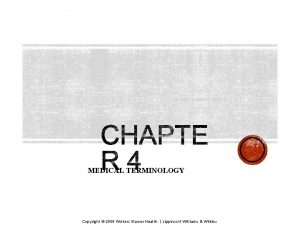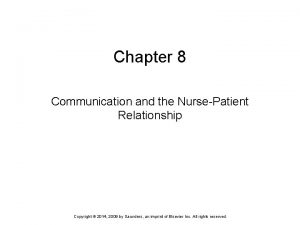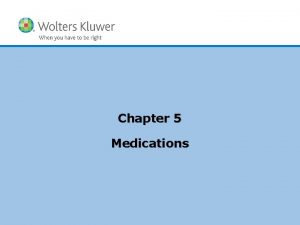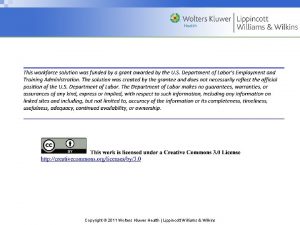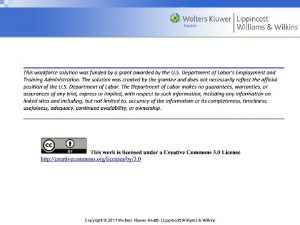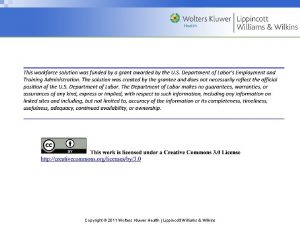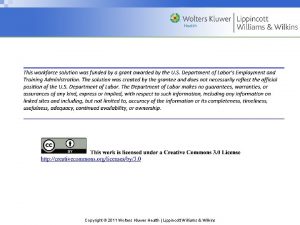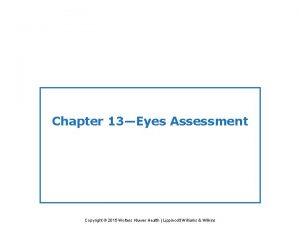Chapter 8 Communication Copyright 2011 Wolters Kluwer Health



































- Slides: 35

Chapter 8 Communication Copyright © 2011 Wolters Kluwer Health | Lippincott Williams & Wilkins

Five Parts of the Communication Process (Berlo) • Stimulus or referent • Sender or source of message (encoder) • Message itself • Medium or channel of communication • Receiver (decoder) Copyright © 2019 Wolters Kluwer • All Rights Reserved

Components in the Process of Communication Copyright © 2019 Wolters Kluwer • All Rights Reserved

Four Levels of Communication • Intrapersonal – Self-talk; communication within a person • Interpersonal – Occurs between two or more people with a goal to exchange messages • Group – Small-group – Organizational communication – Group dynamics Copyright © 2019 Wolters Kluwer • All Rights Reserved

Question #1 A nurse reassuring oneself of being prepared to speak in front of a peer group is using which of the following types of communication? A. Intrapersonal B. Interpersonal C. Group D. Organizational Copyright © 2019 Wolters Kluwer • All Rights Reserved

Answer to Question #1 Answer: A. Intrapersonal Rationale: Intrapersonal communication is self-talk that happens within the individual. Interpersonal communication occurs between two or more people to exchange messages. Group communication includes small-group and organizational group communication. Copyright © 2019 Wolters Kluwer • All Rights Reserved

Characteristics of Effective and Ineffective Groups • Group identity • Cohesiveness • Patterns of interaction • Decision making • Responsibility • Leadership • Power Copyright © 2019 Wolters Kluwer • All Rights Reserved

Factors Influencing Communication • Developmental level • Gender • Sociocultural differences • Roles and responsibilities • Space and territoriality • Physical, mental, and emotional state • Values • Environment Copyright © 2019 Wolters Kluwer • All Rights Reserved

Question #2 Tell whether the following statement is true or false. Touch is a personal behavior that means the same thing to all persons. A. True B. False Copyright © 2019 Wolters Kluwer • All Rights Reserved

Answer to Question #2 Answer: B. False Rationale: Touch is a personal behavior that means different things to different people. Copyright © 2019 Wolters Kluwer • All Rights Reserved

Forms of Communication • Verbal (language) • Nonverbal (body language) – Facial expressions, touch, eye contact – Posture, gait, gestures – General physical appearance – Mode of dress and grooming – Sounds, silence – Electronic communication Copyright © 2019 Wolters Kluwer • All Rights Reserved

Electronic Communication • Social media – Both the American Nurses Association (ANA) and the National Council of State Boards of Nursing (NCSBN) have issued guidelines for RNs regarding use of social media. • E-mail and text messages – The risk for violating patient privacy and confidentiality exists any time a message is sent electronically. – Health care agencies usually have security measures in place to safeguard e-mail and text communications. Copyright © 2019 Wolters Kluwer • All Rights Reserved

The Helping Relationship • Does not occur spontaneously • Characterized by an unequal sharing of information • Built on the patient’s needs • The nurse is the helper, and the patient is the person being helped. • Communication is the means used to establish rapport and helping–trust relationships. Copyright © 2019 Wolters Kluwer • All Rights Reserved

Characteristics of the Helping Relationship • Dynamic • Purposeful and time limited • Person providing assistance is professionally accountable for the outcomes and the means used to attain them Copyright © 2019 Wolters Kluwer • All Rights Reserved

Phases of the Helping Relationship • Orientation phase • Working phase • Termination phase Copyright © 2019 Wolters Kluwer • All Rights Reserved

Question #3 Which activity generally occurs during the orientation phase of the helping relationship? A. An agreement or contract about the relationship is established. B. The nurse provides any assistance needed to achieve patient goals. C. The nurse provides patient counseling and teaching. D. The patient and nurse examine the goals of the helping relationship for indications of attainment. Copyright © 2019 Wolters Kluwer • All Rights Reserved

Answer to Question #3 Answer: A. An agreement or contract about the relationship is established. Rationale: In the orientation phase a contract is made defining the goals of the relationship, frequency, location, length of contacts, and duration of the relationship. The nurse provides assistance needed to achieve patient goals, counseling, and teaching in the working phase. The patient and nurse examine the goals of the helping relationship for indications of attainment in the terminations phase. Copyright © 2019 Wolters Kluwer • All Rights Reserved

Goals of the Orientation Phase • The patient will call the nurse by name. • The patient will accurately describe the roles of the participants in the relationship. • The patient and nurse will establish an agreement about: – Goals of the relationship – Location, frequency, and length of the contacts – Duration of the relationship. Copyright © 2019 Wolters Kluwer • All Rights Reserved

Goals of the Working Phase • The patient will actively participate in the relationship. • The patient will cooperate in activities that work toward achieving mutually acceptable goals. • The patient will express feelings and concerns to the nurse. Copyright © 2019 Wolters Kluwer • All Rights Reserved

Goals of the Termination Phase • The patient will participate in identifying the goals accomplished or the progress made toward goals. • The patient will verbalize feelings about the termination of the relationship. Copyright © 2019 Wolters Kluwer • All Rights Reserved

Factors that Promote Effective Communication • Dispositional traits • Rapport builders Copyright © 2019 Wolters Kluwer • All Rights Reserved

Dispositional Traits • Warmth and friendliness • Openness and respect • Empathy • Honesty, authenticity, trust • Caring • Competence Copyright © 2019 Wolters Kluwer • All Rights Reserved

Rapport Builders • Specific objectives • Comfortable environment • Privacy • Confidentiality • Patient vs. task focus • Utilization of nursing observations • Optimal pacing Copyright © 2019 Wolters Kluwer • All Rights Reserved

Using Hand-Off Communication: SBAR Technique Copyright © 2019 Wolters Kluwer • All Rights Reserved

Developing Conversation Skills • Control the tone of your voice. • Be knowledgeable about the topic of conversation. • Be flexible. • Be clear and concise. • Avoid words that might have different interpretations. • Be truthful. • Keep an open mind. • Take advantage of available opportunities. Copyright © 2019 Wolters Kluwer • All Rights Reserved

Developing Listening Skills • Sit when communicating with a patient. • Be alert and relaxed and take your time. • Keep the conversation as natural as possible. • Maintain eye contact if appropriate. • Use appropriate facial expressions and body gestures. • Think before responding to the patient. • Do not pretend to listen. • Listen for themes in the patient’s comments. • Use silence, therapeutic touch, and humor appropriately. Copyright © 2019 Wolters Kluwer • All Rights Reserved

Listening Attentively is Key to Productive Communication Copyright © 2019 Wolters Kluwer • All Rights Reserved

Interviewing Techniques • Open-ended questions or comments • Closed questions or comments • Validating questions or comments • Clarifying questions or comments • Reflective questions or comments • Sequencing questions or comments • Directing questions or comments Copyright © 2019 Wolters Kluwer • All Rights Reserved

Characteristics of the Assertive Nurse’s Self-Presentation • Confident; open body posture • Use of clear, concise “I” statements • Ability to share effectively one’s thoughts, feelings, and emotions • Working to capacity with or without supervision • Remaining calm under supervision • Asking for help when necessary • Giving and accepting compliments • Admitting mistakes and taking responsibility for them Copyright © 2019 Wolters Kluwer • All Rights Reserved

Aggressive Behavior • Involves asserting one’s rights in a negative manner that violates the rights of others • Can be verbal or physical • Communication is marked by tension and anger, inhibiting the formation of good relationships and collaboration. • Characteristics include using an angry tone of voice, making accusations, and demonstrating belligerence and intolerance. • Focus is usually “winning at all costs. ” Copyright © 2019 Wolters Kluwer • All Rights Reserved

Blocks to Communication • Failure to perceive the patient as a human being • Failure to listen • Nontherapeutic comments and questions • Using clichés • Using closed questions • Using questions containing the words “why” and “how” • Using questions that probe for information Copyright © 2019 Wolters Kluwer • All Rights Reserved

Blocks to Communication (cont. ) • Using leading questions • Using comments that give advice • Using judgmental comments • Changing the subject • Giving false assurance • Using gossip and rumors • Using disruptive interpersonal behavior Copyright © 2019 Wolters Kluwer • All Rights Reserved

Question #4 Tell whether the following statement is true or false. An open-ended question or comment serves to validate what the nurse believes is heard or observed. A. True B. False Copyright © 2019 Wolters Kluwer • All Rights Reserved

Answer to Question #4 Answer: B. False Rationale: A validating question or comment serves to validate what the nurse believes is heard or observed. Copyright © 2019 Wolters Kluwer • All Rights Reserved

Disruptive Interpersonal Behavior • Incivility • Bullying – Horizontal violence – Nurse bullying – Negative communication between nurse and physician • Organizational response to disruptive behaviors Copyright © 2019 Wolters Kluwer • All Rights Reserved
 Wolters kluwer health
Wolters kluwer health Wolters kluwer health
Wolters kluwer health Wolters kluwer health
Wolters kluwer health Wolters kluwer
Wolters kluwer Wolters kluwer
Wolters kluwer Wolters kluwer health
Wolters kluwer health Wolters kluwer health
Wolters kluwer health Wolters kluwer
Wolters kluwer Wolters kluwer health lippincott williams & wilkins
Wolters kluwer health lippincott williams & wilkins Wolters kluwer
Wolters kluwer Wolters kluwer
Wolters kluwer Synaptic integration
Synaptic integration Wolters kluwer
Wolters kluwer Wolters kluwer
Wolters kluwer Chapter 25 assessment of cardiovascular function
Chapter 25 assessment of cardiovascular function Virchow's triad
Virchow's triad Wolters kluwer pronunciation
Wolters kluwer pronunciation Wolters kluwer
Wolters kluwer Copyright
Copyright Wolters kluwer
Wolters kluwer Wolters kluwer
Wolters kluwer Wolters kluwer
Wolters kluwer Wolters kluwer ovid
Wolters kluwer ovid Wolters kluwer culture
Wolters kluwer culture Wolters kluwer pronunciation
Wolters kluwer pronunciation Kluwer
Kluwer Kluwer congres
Kluwer congres Ministerial priorities
Ministerial priorities Chapter 3 health wellness and health disparities
Chapter 3 health wellness and health disparities Chapter 1 understanding health and wellness lesson 2
Chapter 1 understanding health and wellness lesson 2 Chapter one understanding health and wellness
Chapter one understanding health and wellness Chapter 8 health team communication
Chapter 8 health team communication Role of occupational health nurse
Role of occupational health nurse National programmes related to nutrition
National programmes related to nutrition Health standards louisiana
Health standards louisiana Difference between health promotion and health education
Difference between health promotion and health education







